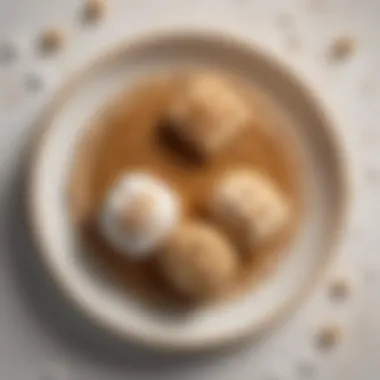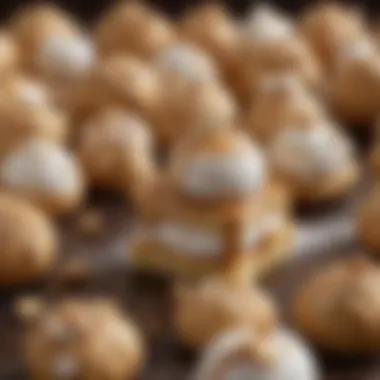Exploring the Fusion of Peanut Butter and Marshmallow


Intro
The combination of peanut butter and marshmallow is one that speaks to many people, often evoking memories of childhood treats and classic desserts. Both of these ingredients have distinct characteristics that not only complement each other but also enhance the overall culinary experience. Peanut butter, with its rich, nutty flavor, is a protein-packed spread beloved by many. Marshmallow, on the other hand, brings a sweet and fluffy texture that contrasts beautifully with the denser peanut butter. Understanding their historical backgrounds can provide insights into why they work so well together in various dishes.
This exploration will take you through the individual traits of these ingredients, their origins, and the ways they can be united creatively in the kitchen. We will dive into recipes that showcase their synergy and offer preparation techniques that can enhance their flavors even further. Whether you're a seasoned chef or a culinary enthusiast, this journey will enrich your understanding and inspire new ideas for incorporating peanut butter and marshmallow into your cooking.
Recipe Overview
| Recipe name | Peanut Butter Marshmallow Swirl Brownies | | Brief description of the dish | A decadent brownie infused with creamy peanut butter and topped with a delightful marshmallow swirl, perfect for satisfying any sweet tooth.
Ingredients List
- Main ingredients
- Optional ingredients
- 1 cup of smooth peanut butter
- 1 cup of sugar
- 2 large eggs
- 1 teaspoon of vanilla extract
- 1/2 cup of all-purpose flour
- 1 cup of marshmallow fluff
- 1/2 cup of semi-sweet chocolate chips
- A pinch of salt for enhancing flavor
- Chopped nuts for added texture
- Cocoa powder to add depth to the brownie base
This recipe provides a rich and satisfying treat that balances the sweetness of marshmallow with the nutty depth of peanut butter. The preparation process will blend these flavors beautifully, leading to a dessert that resonates with both traditional and innovative culinary principles.
Foreword to Peanut Butter and Marshmallow
Exploring the fusion of peanut butter and marshmallow unveils not just a pairing of flavors, but a juxtaposition of textures and histories. This section lays the groundwork for a deeper understanding of these two beloved ingredients and their cultural significance. The journey begins with the rise of peanut butter, a staple in many households worldwide, and the historical evolution of marshmallow, which has its roots in ancient confections. By examining both elements, we can appreciate their unique contributions to the culinary world and why they are often combined.
The Rise of Peanut Butter
Peanut butter has grown from a simple snack to an essential component in many cuisines. Originally developed in the United States in the 19th century, it gained popularity due to its nutritional benefits and versatility. Peanut butter is known for its rich source of protein, healthy fats, and vitamins, making it a desirable option for those seeking both flavor and nutrition.
The spreadability of peanut butter gives it a unique edge over other nut butters. It can be enjoyed in a variety of ways, from classic sandwiches to more modern applications like smoothies and cookies. Its rise can be attributed to the booming health food culture, where it is seen as a healthy alternative to processed spreads. The simplicity in its production, mainly grinding roasted peanuts into a paste, has also contributed to its accessibility and widespread appeal among consumers, both in households and gourmet settings.
History of Marshmallow
The marshmallow has a fascinating background that contrasts sharply with the contemporary fluffy treat that many enjoy today. Initially, marshmallows were crafted from the sap of the marshmallow plant, Althaea officinalis. This plant's roots were extracted and mixed with sugar and egg whites, resulting in a delicate confection. Ancient Egyptians used to reserve this treat for gods and Pharaohs, signifying its elite status.
The transformation of marshmallow from a rare indulgence to a mass-produced favorite occurred in the late 19th century. Thanks to advancements in manufacturing techniques, specifically the introduction of gelatin, marshmallows became easier to produce at scale. Today, they are ubiquitous in candies, desserts, and unique culinary creations. The combination of sweetness and soft texture of marshmallow enhances dishes ranging from hot cocoa to pie toppings. The historical evolution offers a glimpse into changing consumer preferences and the adaptability of food.
"Understanding the backgrounds of these ingredients enriches the culinary experience, showing how traditions shape modern flavors."


In summary, this journey through the rise of peanut butter and the history of marshmallow provides context for their unique flavors and textures. It sets the stage for exploring how these ingredients complement each other and inspire new creative applications in the kitchen.
Nutritional Profile
Understanding the nutritional profile of peanut butter and marshmallow is essential for uncovering their appeal in various culinary applications. Each of these ingredients brings unique characteristics to the table, influencing not just flavor, but also dietary considerations. By exploring their nutritional content, we can appreciate how these two staples complement each other, enriching our meals.
Peanut Butter's Health Benefits
Peanut butter is often celebrated for its rich nutrient content and health benefits. It is a great source of protein, which is essential for muscle repair and growth. A typical serving contains around 8 grams of protein, making it an effective component in a balanced diet.
Additionally, peanut butter provides healthy fats, primarily unsaturated fats, which contribute to heart health. Specifically, these fats can help lower bad cholesterol levels, thus reducing the risk of cardiovascular diseases. Essential vitamins and minerals, such as vitamin E, magnesium, and potassium, are also present in significant amounts. These nutrients support various bodily functions, including nerve and muscle function.
However, it is important to consume peanut butter in moderation. It is calorie-dense, with approximately 190-200 calories per two-tablespoon serving. Those who are managing their weight should be mindful of portion sizes.
Marshmallow: A Closer Look
Marshmallow might not have the same health acclaim as peanut butter, but it holds its own unique attributes. Primarily made from sugar, water, and gelatin, marshmallow lacks significant vitamins and minerals compared to peanut butter. Its main appeal lies in its delightful sweetness and texture. This makes it a preferred choice for various desserts and snacks, enhancing the overall flavor profile when paired with peanut butter.
Though marshmallow is viewed as a treat rather than a health food, it can offer moments of joy in culinary creativity. Moderation is key, especially for those watching their sugar intake. Its lightness juxtaposes the dense richness of peanut butter, providing a balance in recipes.
The combination of these two ingredients creates a familiar harmony, presenting both taste and texture that appeals to many.
"In culinary practices, understanding the nutritional properties of ingredients is vital for making informed choices that align with health goals."
Culinary Applications
Exploring the culinary applications of peanut butter and marshmallow is essential to appreciate how these two ingredients harmoniously work together. Their complementary flavors and textures create an array of possibilities in the kitchen. The sweet richness of marshmallow balances the dense, nutty flavor of peanut butter. Therefore, incorporating these two in various dishes enables chefs and home cooks to craft desserts and snacks that delight the palate. Examining classic recipes helps in understanding their traditional uses. Meanwhile, modern adaptations showcase their versatility in contemporary cuisine.
Classic Recipes Featuring Peanut Butter and Marshmallow
Peanut Butter and Marshmallow Sandwich
The peanut butter and marshmallow sandwich is a staple that has stood the test of time. This simple creation combines the rich, creamy texture of peanut butter with the fluffy sweetness of marshmallow. It offers a satisfying bite that appeals to both children and adults alike. One key characteristic is its ease of preparation. Just spread the two ingredients between slices of bread, and you have a quick meal or snack. However, the reliance on bread can be a downside for those avoiding gluten or looking for lower-carb options.
Rice Krispie Treats with Peanut Butter
Rice Krispie treats infused with peanut butter take the traditional recipe to a new level. The addition of peanut butter brings a nutty flavor that enhances the sweetness of the marshmallows while adding a different texture. They are chewy and provide a delightful crunch from the cereal. This adaptation makes it popular among families seeking a fun treat. A notable advantage is their ability to be prepared quickly, yet their rich flavor may not be suitable for everyone, especially those watching their sugar intake.
Peanut Butter S'mores


Peanut butter s'mores introduce a twist to the classic campfire favorite. Instead of simply using chocolate, combining peanut butter into the mix elevates the overall flavor profile. This takes the sugary experience to another dimension, making it richer and more satisfying. The gooeyness of melted marshmallows complements the peanut butter perfectly, creating a wonderful taste sensation. However, a potential disadvantage can be the messiness associated with eating them, especially when they are heated.
Innovative Uses in Modern Cuisine
Peanut Butter Marshmallow Dip
Peanut butter marshmallow dip presents a modern twist on traditional dips. This blend offers a creamy and sweet accompaniment for fruits, pretzels, or graham crackers. Its rich, indulgent flavor makes it a hit at parties or gatherings. One key feature is its versatility. You can easily customize it by adding chocolate or spices. However, it can be quite sweet, which may not suit all tastes.
Peanut Butter Marshmallow Cake
This cake combines layers of peanut butter and marshmallow in a decadent dessert. The creaminess of peanut butter mixed with the lightness of marshmallow creates an inviting texture. This dessert excels during celebrations or special occasions. A unique feature is that it can be dressed up or down, depending on the occasion. Yet, it may be seen as overly sweet for some, which should be taken into account.
Gelato and Frozen Desserts
Integrating peanut butter and marshmallow into gelato or other frozen desserts brings forth a refreshing take on classic flavors. The creamy texture of gelato marries perfectly with the sweet notes of marshmallow, creating a delightful treat. This combination is popular in ice cream shops, offering a unique taste experience. The key characteristic here is its indulgence; these flavors are rich and satisfying, yet they are best enjoyed in moderation due to their high sugar content.
Exploring Pairings
Pairing ingredients is a fundamental aspect of culinary practice. It enhances flavors and creates a more enjoyable eating experience. In exploring the intersection of peanut butter and marshmallow, understanding complementary ingredients and seasonal combinations can elevate their use. This section will delve into specific pairings, highlighting their individual nuances and contributions.
Complementary Ingredients
Chocolate and Peanut Butter
The combination of chocolate and peanut butter is celebrated for its versatility and richness. Chocolate adds a layer of sweetness and a slightly bitter depth that balances the earthy, nutty flavor of peanut butter. This duo often appears in desserts like brownies and candies, but it can also enhance breakfast options, such as chocolate-peanut butter smoothies. The unique feature of this combination lies in its widespread appeal, as it caters to both sweet and savory palates. However, care should be taken to avoid overwhelming the peanut butter’s flavor. A balance in proportions will yield a satisfying experience.
Fruits: Banana and Apples
Fruits such as bananas and apples offer a fresh contrast to the creamy texture of peanut butter and the sweetness of marshmallow. Banana, with its natural sweetness, pairs well with peanut butter in smoothies and snacks. Apples, crisp and refreshing, can serve as a perfect vehicle for both peanut butter and marshmallow in sandwiches or dip. The key characteristic of these fruits is their ability to complement without overpowering. The disadvantage may be that not everyone enjoys the combination of fruits and marshmallow, leading to mixed preferences.
Nut Variations
Incorporating different nuts alongside peanut butter can introduce new textures and flavors. Almonds, cashews, and hazelnuts, for instance, offer distinct tastes that can enhance dishes when paired with marshmallow. The key characteristic of nut variations is their health benefits and textural contrast. They provide additional nutrients and can appeal to those seeking alternatives to traditional combinations. One downside is the potential for allergies, which should be considered when serving these pairings.
Seasonal Flavor Combinations
Spring: Citrus and Honey
Spring brings a refreshing burst of citrus that pairs well with the sweetness of marshmallow. Citrus fruits, such as oranges and lemons, add bright acidity, while honey provides natural sweetness. This combination is particularly beneficial for light desserts and salads. The unique feature is its ability to balance sweetness and tartness effectively. However, care should be taken to ensure the citrus does not overshadow marshmallow’s delicate flavor.


Autumn: Pumpkin Spice
As autumn arrives, flavors like pumpkin spice become popular. This combination with peanut butter creates a warm and comforting experience, perfect for pies or snacks. The key characteristic is the blend of spices that complement the nutty flavor of peanut butter, evoking nostalgia for many. A potential disadvantage is that this pairing might feel seasonal, limiting its use outside autumn.
Winter: Mint and Vanilla
During the winter months, mint offers a refreshing contrast to the rich flavors of peanut butter and marshmallow. Mint can uplift the heaviness, while vanilla adds warmth and sweetness. This pairing is especially well-suited for desserts like cookies and cakes. The unique benefit is the refreshing aftertaste of mint, which balances the peanut butter's density. However, overindulgence in mint could overpower other flavors, so balance is essential.
Pairing different flavors and textures can turn a simple dish into a culinary delight. Understanding how to blend these elements is crucial in creating memorable meals.
Popular Trends and Community Impact
The fusion of peanut butter and marshmallow has gained significant traction in recent culinary trends. This dynamic duo not only captivates taste buds but also shapes culinary discussions across social platforms. The growing popularity of this combination reflects a broader trend where nostalgic flavors intermingle with modern cooking techniques.
Social Media Influence on Recipes
Social media platforms have become key players in the dissemination of culinary trends. Recipes featuring peanut butter and marshmallow are often shared widely, with vibrant images capturing attention immediately. Instagram, TikTok, and Pinterest are hotspots for these creative concoctions, making them accessible to a global audience.
Food enthusiasts often showcase their own interpretations of classic recipes. The ease of posting allows for instant feedback and variations, fostering a sense of community among food lovers. This trend reinforces the power of visual appeal in food presentation and encourages users to experiment more in their kitchens.
"As food creativity has risen on social media, classic flavors like peanut butter and marshmallow are reinvented daily, bringing new life to familiar treats."
Peanut Butter and Marshmallow in Culinary Culture
Peanut butter and marshmallow have transcended simple snacks to become cultural icons. In American culinary history, these ingredients are well-known comfort foods. They bring nostalgia, associated with childhood treats and family gatherings. The combination often appears in regional desserts, such as rice crispy treats or s'mores, each laden with memories and shared moments.
Culinary culture today also embraces inclusivity and experimentation. For example, numerous gluten-free and vegan alternatives are now available. This pushes traditional boundaries, allowing more people to enjoy this beloved pair. From bakeries to home kitchens, the versatility of peanut butter and marshmallow fosters creativity, encouraging chefs to push the envelope on more elaborate desserts.
Moreover, the shared love for these flavors connects people, creating diverse recipes that highlight regional influences. Local communities embrace this fusion, with food fairs and competitions celebrating the unique blend of peanut butter and marshmallow dishes. This cultural integration has enhanced the communal experience around food preparation and consumption while ensuring its relevance in contemporary cuisine.
Epilogue
The fusion of peanut butter and marshmallow represents a captivating exploration into flavors and textures. This conclusion serves to encapsulate the essence of the entire culinary journey discussed in this article. From the historical backgrounds of each ingredient to their modern applications, understanding this relationship helps highlight not only their delightful combination but also their significance in various culinary contexts.
Summarizing the Flavor Journey
To summarize the flavor journey, it is crucial to revisit the key points made throughout the discussions. Peanut butter, with its rich, nutty profile, pairs beautifully with the sweet, airy texture of marshmallow. The article emphasized the versatility of these ingredients, evidenced through traditional recipes like the peanut butter and marshmallow sandwich, alongside innovative creations such as peanut butter marshmallow dip.
The blending of these flavors can evoke nostalgia while also satisfying the craving for something unique. This fusion encourages culinary experimentation, reminding food lovers that there is always room for creativity in the kitchen.
Encouraging Culinary Exploration
Encouraging culinary exploration is essential in broadening one’s cooking skills and palate. When one dives into the world of peanut butter and marshmallow combinations, endless possibilities arise. Here are a few considerations to spark creativity:
- Experiment with textures: Try incorporating crunchy peanut butter with fluffy marshmallow for a layered dessert.
- Explore global flavors: Combine these ingredients with spices or flavors from different cultures to discover new profiles.
- Make it seasonal: Adjust recipes according to the seasons by introducing fruits or spices that complement the basics.
Engaging with food can enrich experiences and foster a deeper connection to culinary arts. This article aims to inspire readers to embrace the journey of mixing and matching flavors, particularly the must-try pairing of peanut butter and marshmallow.







